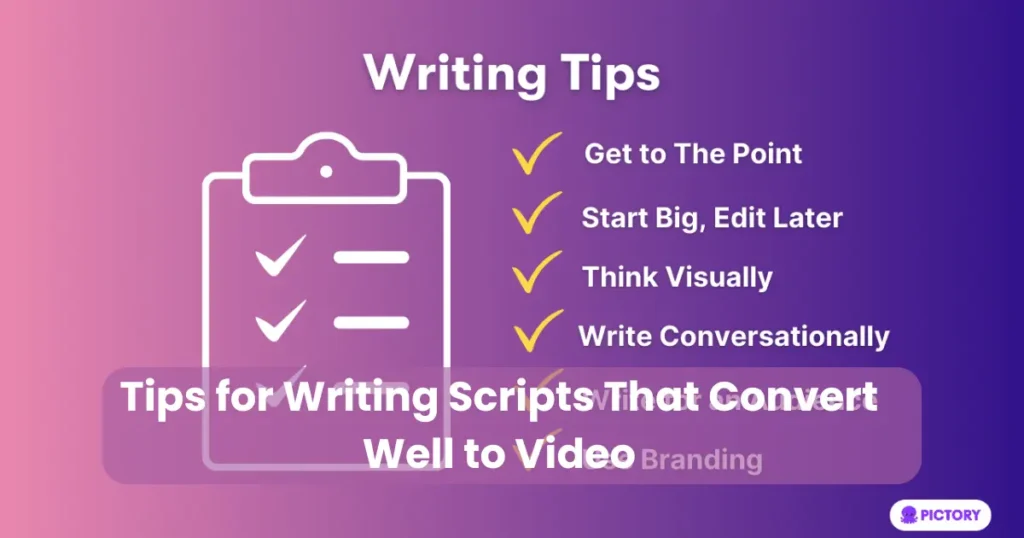
AI Videos
AI Script to Video Tool Guide

Contents
- 1 What Is an AI Script to Video Tool?
- 2 Benefits of Using AI Tools for Script-to-Video Creation
- 3 Key Features to Look for in an AI Script to Video Tool
- 4 Top AI Script to Video Tools in 2025
- 5 How to Use an AI Script to Video Tool
- 6 Tips for Writing Scripts That Convert Well to Video
- 7 AI Script to Video Tool Guide: Best Practices
- 7.1 1. Always Start with a Clear Objective
- 7.2 2. Keep Your Script Audience-Centric
- 7.3 3. Choose the Right Voice and Style
- 7.4 4. Let the AI Handle Automation—but Review Thoroughly
- 7.5 5. Use Visual Cues and Transitions Strategically
- 7.6 6. Optimize for Different Platforms
- 7.7 7. Track Performance After Publishing
- 7.8 8. Stay Updated with New Features
- 8 Conclusion
In today’s digital-first world, video content reigns supreme. Whether you’re a marketer, educator, or content creator, producing engaging videos quickly is no longer a luxury—it’s a necessity. That’s where this AI script to video tool guide comes in. With the help of AI, turning written scripts into compelling videos has never been easier or more efficient.
Thanks to the rise of advanced AI tools, even beginners can now generate high-quality videos without hiring professional editors or voice actors. These platforms take your written script and automatically add visuals, voiceovers, music, and transitions, dramatically cutting down production time.
Furthermore, businesses can use these tools to scale content creation, boost audience engagement, and maintain brand consistency—without needing a full in-house team. In the sections ahead, we’ll explore how these tools work, which features matter most, and which AI tools lead the market in 2025.
What Is an AI Script to Video Tool?
An AI script to video tool is a software application that leverages artificial intelligence to transform written scripts into fully produced videos—often in a matter of minutes. These tools are designed to simplify the video creation process by automating key steps such as scene selection, voiceover generation, background music integration, and visual editing.
Rather than manually piecing together footage, users can simply paste their script into the tool’s interface. From there, the AI analyzes the text, understands the context, and assembles a cohesive video using pre-built templates, avatars, or animations. As a result, what once required a team of editors and hours of work can now be done with just a few clicks.
Moreover, many AI video tools include features like customizable branding, language translation, and text-to-speech synthesis. Because of this, they are widely used across industries—from online education and digital marketing to corporate training and YouTube content creation.
In short, an AI script to video tool bridges the gap between written content and dynamic visual storytelling, making video production faster, smarter, and far more accessible than ever before.
Benefits of Using AI Tools for Script-to-Video Creation
Using an AI script to video tool offers numerous benefits that go far beyond saving time. As technology continues to evolve, these tools are becoming essential for creators and businesses who want to stay ahead in the content game. Let’s dive into the key advantages.

1. Time Efficiency
First and foremost, speed is a major advantage. Traditional video production can take days or even weeks, but with AI, scripts can be transformed into videos within minutes. This quick turnaround allows teams to react faster to trends or deliver frequent content without burnout.
2. Cost Savings
Additionally, AI tools reduce the need for large production budgets. Since you no longer need to hire voice actors, video editors, or animators, you can produce high-quality content with minimal expenses. This is particularly helpful for startups, educators, and solopreneurs.
3. Ease of Use
Most AI platforms are designed with user-friendliness in mind. Even if you have no background in video editing, drag-and-drop interfaces and automated features make the process intuitive. As a result, professional videos can be made by anyone, regardless of technical skill.
4. Scalability
Furthermore, AI makes it easy to scale your content production. Whether you’re creating ten videos or a hundred, AI ensures consistency in voice, tone, and visuals—something that’s difficult to maintain with manual editing.
5. Multilingual Capabilities
To reach global audiences, many AI tools offer automatic translation and multilingual voiceovers. This feature expands your reach without hiring a full localization team.
6. Creative Flexibility
Lastly, while AI automates much of the work, it still allows for creative input. Users can customize scenes, voices, colors, and styles to align with brand identity and storytelling goals.
Key Features to Look for in an AI Script to Video Tool
Choosing the right AI script to video tool can be overwhelming, especially with so many options on the market. However, understanding the key features to prioritize can simplify your decision and ensure you get the best results for your content needs. Below are the most important elements to consider before making a choice.

1. Text-to-Speech (TTS) Options
One of the core features is a high-quality text-to-speech engine. Look for tools that offer natural-sounding voices, multiple accents, and various languages. This ensures your script is delivered in a tone that matches your audience and brand.
2. Template Library
Next, evaluate the availability of video templates. A diverse template library allows users to create different styles of content—from explainers to social media posts—without starting from scratch every time.
3. Media Asset Integration
Many AI tools include access to royalty-free stock images, video clips, and music tracks. These assets are automatically matched to your script, enhancing the visual appeal without the need to upload your own files.
4. AI Scene Generation
A robust scene generation engine should be included. This feature allows the tool to break down your script, assign relevant visuals, and build cohesive scenes with proper timing, transitions, and formatting.
5. Avatar or Presenter Features
To humanize the content, some tools include AI avatars or animated presenters. If personal connection is important for your audience, this feature can be a huge plus—especially for training or educational content.
6. Customization Controls
Although automation is great, having creative control is even better. Look for tools that allow you to adjust colors, fonts, layouts, background music, and voice settings to maintain your brand identity.
7. Multilingual Support
If you plan to target a global audience, multilingual functionality is a must. Top tools offer automatic translation, voiceovers in different languages, and subtitle generation for inclusivity.
8. Export and Sharing Options
Finally, pay attention to the export quality (HD or 4K), file formats, and direct sharing options to platforms like YouTube, Vimeo, or social media. A smooth publishing process saves time and increases efficiency.
Top AI Script to Video Tools in 2025
As demand grows for fast, affordable video production, a number of standout tools have emerged in the AI space. Each offers unique features tailored to different user needs. Below is a curated list of the best options to explore in this AI script to video tool guide for 2025.

1. Synthesia
Synthesia is one of the most advanced AI video generators available. It allows users to turn scripts into videos with lifelike AI avatars that speak in multiple languages. Corporate teams, educators, and marketers frequently use it for training and explainer videos. Moreover, its user interface is clean, and the video output is impressively professional.
Key Features:
- 140+ AI avatars
- 120+ languages and voices
- Easy script input and video preview
- Custom avatar creation (premium)
2. Pictory
Pictory specializes in turning long-form content into engaging video summaries. If you have a blog post or webinar script, this tool can break it down into highlights, adding visuals and narration automatically. Because of its simplicity, it’s ideal for content repurposing.
Key Features:
- Text-to-video and blog-to-video support
- Auto-captioning and transcription
- AI voiceovers
- Custom branding options
3. Lumen5
Lumen5 blends AI automation with creative flexibility. Known for its marketing-focused approach, it turns scripts into short, social media-friendly videos. Transitions are smooth, and templates are stylish. Best of all, it’s easy enough for beginners and robust enough for pros.
Key Features:
- Drag-and-drop editor
- Stock media library
- Text-to-video workflow
- Brand presets and styles
4. InVideo
InVideo offers both AI-powered automation and manual editing tools, which makes it extremely versatile. It caters to marketers, educators, and entrepreneurs who want more control over visuals and timing. Its template-rich dashboard is a bonus.
Key Features:
- 5,000+ templates
- Text-to-video AI editor
- Custom voiceover recording
- Team collaboration tools
How to Use an AI Script to Video Tool
Using an AI script to video tool is a simple process, even for those with no prior experience in video editing. These platforms are designed with intuitive interfaces and automation features that streamline content creation. To help you get started, here’s a step-by-step walkthrough on how to use these tools effectively.

1: Choose the Right Tool
First, select a platform from the options listed in this AI script to video tool guide. Each tool has unique strengths, so base your decision on your content goals—whether that’s professional training videos, marketing content, or educational explainers.
2: Write or Paste Your Script
Once you’ve logged into the tool, locate the script input area. You can either type your content directly or paste it from another document. Be sure to review the text for grammar and flow, as the AI will use it to generate narration and scene structure.
3: Select a Voice or Avatar
Next, choose from available voiceovers or AI avatars. Most tools offer multiple languages, tones, and accents. If the video requires a more personal touch, select an avatar that best fits your audience and topic.
4: Customize Visual Elements
After the script is uploaded, the AI automatically matches visuals to your text. However, you can customize the scenes by:
- Changing background images or videos
- Adjusting font styles and colors
- Inserting logos or call-to-action buttons
This flexibility helps ensure brand alignment and visual appeal.
5: Add Music and Transitions
To enhance viewer engagement, select background music and transitions. Most tools offer royalty-free libraries, and transitions can be automatically placed between scenes for a smooth flow.
6: Preview and Edit
Before finalizing, preview the entire video. Watch for timing issues, mispronunciations, or misplaced visuals. Minor edits can be made quickly within the tool’s built-in editor.
Finally, export the video in your desired resolution (usually HD or 4K). Many platforms offer direct sharing to social media channels, YouTube, or internal communication tools like Slack or Teams.
Tips for Writing Scripts That Convert Well to Video
No matter how advanced an AI script to video tool is, the quality of your final video heavily depends on the quality of your script. Writing with video in mind can make a massive difference in how engaging, clear, and impactful the end product becomes. Below are some essential tips to help you write scripts that convert effectively to video.

1. Start with a Strong Hook
To capture attention within the first few seconds, open your script with a compelling hook. Ask a question, present a bold statement, or describe a relatable problem. Viewers decide quickly whether to keep watching—give them a reason to stay.
2. Keep Sentences Short and Conversational
Short, punchy sentences are easier for AI voiceovers to deliver and for audiences to follow. Since video is a visual and auditory medium, use natural language and a conversational tone to maintain clarity and flow.
3. Use Visual Language
To help the AI match visuals to your narration, include descriptions that suggest imagery. For example, instead of saying “We help businesses grow,” try “We help businesses grow through data-driven marketing strategies, illustrated by rising graphs and client success stories.”
4. Break Up the Content Into Scenes
Segment your script into clear scenes or sections. This allows the AI script to video tool to generate visual transitions more logically, improving the pacing and storytelling structure.
5. Add Cues for Emotion or Emphasis
If your AI platform allows it, include tags for tone or emphasis (e.g., [excited], [serious], [whisper]). Doing so ensures your message is delivered in the right mood and keeps the viewer emotionally engaged.
6. Include a Call-to-Action (CTA)
Every good video has a purpose. End your script with a strong CTA—such as “Visit our website,” “Download the app,” or “Subscribe now.” Make it clear, direct, and easy to act on.
7. Revise and Read Aloud
Finally, read your script aloud to ensure it flows naturally and sounds human. If it feels robotic, your audience will notice. Many AI tools rely on pacing and voice intonation, so this final check can significantly boost your results.
AI Script to Video Tool Guide: Best Practices
To make the most out of your AI script to video tool, applying best practices is essential. While these tools offer automation and speed, using them strategically can elevate your content from good to great. Below are proven practices to ensure your videos are effective, professional, and engaging.

1. Always Start with a Clear Objective
Before opening your tool, define the video’s goal. Are you trying to educate, sell, inspire, or entertain? When your objective is clear, your script structure, visuals, and voiceovers will align seamlessly.
2. Keep Your Script Audience-Centric
Effective videos are tailored to the viewer’s needs. Therefore, write your script as if you’re speaking directly to your audience. Use “you” language, focus on their pain points, and offer solutions to build connection and relevance.
3. Choose the Right Voice and Style
Every message has a tone—make sure the AI voice or avatar matches it. For example, professional presentations benefit from calm, formal tones, while promotional videos may require something energetic and upbeat.
4. Let the AI Handle Automation—but Review Thoroughly
Although most of the video creation is handled by the AI, never skip the review phase. Automated scene generation may not always perfectly match your intent. Thus, reviewing each scene ensures consistency in branding, messaging, and visual flow.
5. Use Visual Cues and Transitions Strategically
Transitions help your video flow smoothly from one point to the next. Likewise, visual cues—like on-screen text, icons, or motion graphics—can reinforce key messages and improve viewer retention.
6. Optimize for Different Platforms
Depending on where your video will be posted—YouTube, LinkedIn, Instagram, or your website—formatting will differ. Make use of aspect ratio settings, subtitles, and call-to-actions suited for each platform’s best practices.
7. Track Performance After Publishing
Once your video is live, monitor its performance. Metrics like watch time, click-through rate (CTR), and engagement can offer insights. Over time, this data helps you refine how you use your chosen AI script to video tool.
8. Stay Updated with New Features
These tools evolve quickly. Therefore, staying updated with the latest capabilities—such as new voices, avatar styles, or editing enhancements—can keep your videos looking modern and ahead of the competition.
Conclusion
In today’s fast-paced digital landscape, video content has become essential for brands, educators, marketers, and creators alike. With the rise of automation and artificial intelligence, producing high-quality videos no longer requires expensive software or a full production team. As demonstrated throughout this AI script to video tool guide, these innovative platforms simplify video creation while offering impressive results.
By selecting the right tool, writing effective scripts, and applying best practices, anyone can transform written content into engaging videos. Whether you’re making explainer videos, product promos, tutorials, or social media clips, an AI script to video tool empowers you to do it faster, easier, and smarter.
Ultimately, staying consistent and creative will keep your content fresh and compelling. As these tools evolve, so will your ability to connect with your audience on a deeper level. So, take the next step—choose your favorite tool, write a great script, and start creating with confidence. This AI script to video tool guide is here to help you every step of the way.


How to Edit AI-Generated Videos Effectively
Updated on April 27, 2025
Read More